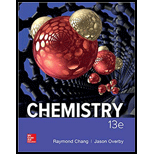
Concept explainers
- a)
Interpretation: The given complex ion of a coordination compound to be interpreted.
Concept Introduction:
Lewis acid: The species which accepts the lone pair of electrons.
Lewis base: The species which donates lone pair of electrons.
Donor atom: The neutral molecule or the negatively charged species which donates pair of electrons is known as Donor atom.
Coordinate covalent bonds: A covalent bond in which the Ligand donates both electrons to the metal ion to construct a bonding interaction known as coordinate covalent bond.
To Identify: The given complex ion of a coordination compound to be interpreted.
- b)
Interpretation: The given complex ion of a coordination compound to be interpreted.
Concept Introduction:
Lewis acid: The species which accepts the lone pair of electrons.
Lewis base: The species which donates lone pair of electrons.
Donor atom: The neutral molecule or the negatively charged species which donates pair of electrons is known as Donor atom.
Coordinate covalent bonds: A covalent bond in which the Ligand donates both electrons to the metal ion to construct a bonding interaction known as coordinate covalent bond.
To Identify: The given complex ion of a coordination compound to be interpreted.
- c)
Interpretation: The given complex ion of a coordination compound to be interpreted.
Concept Introduction:
Lewis acid: The species which accepts the lone pair of electrons.
Lewis base: The species which donates lone pair of electrons.
Donor atom: The neutral molecule or the negatively charged species which donates pair of electrons is known as Donor atom.
Coordinate covalent bonds: A covalent bond in which the Ligand donates both electrons to the metal ion to construct a bonding interaction known as coordinate covalent bond.
To Identify: The given complex ion of a coordination compound to be interpreted.
- d)
Interpretation: The given complex ion of a coordination compound to be interpreted.
Concept Introduction:
Lewis acid: The species which accepts the lone pair of electrons.
Lewis base: The species which donates lone pair of electrons.
Donor atom: The neutral molecule or the negatively charged species which donates pair of electrons is known as Donor atom.
Coordinate covalent bonds: A covalent bond in which the Ligand donates both electrons to the metal ion to construct a bonding interaction known as coordinate covalent bond.
To Identify: The given complex ion of a coordination compound to be interpreted.
Trending nowThis is a popular solution!

Chapter 23 Solutions
CHEMISTRY (LL) W/CNCT >BI<
- What is the missing intermediate 1 and the final product 2. Please include a detailed explanation explaining the steps of malonic ester synthesis. Please include drawings of the intermediate and how it occurs and how the final product is former.arrow_forwardWhat would be the reagents and conditions above and below the arrow that will complete the proposed acetoacetic ester synthesis? If it cannot be done efficiently, then I will choose that answer. There could be 2 or 4 reagents involved. Please provide a detailed explanation and drawings showing how it would proceed with the correct reagents.arrow_forwardFor benzene, the ∆H° of vaporization is 30.72 kJ/mol and the ∆S° of vaporization is 86.97 J/mol・K. At 1.00 atm and 228.0 K, what is the ∆G° of vaporization for benzene, in kJ/mol?arrow_forward
- The reaction Q(g) + R(g) → Z(l) is shown to be exothermic. Which of the following is true concerning the reaction. it is spontaneous only at High T, it is spontaneous at low T it is nonspontaneous at all T it is spontanrous at all T. it is non spontaneous only at low T.arrow_forwardThe reaction Q(g) + R(g) → Z(l) is shown to be exothermic. Which of the following is true concerning the reactionarrow_forwardWhich of the following has the largest standard molar entropy, S° (298.15 K) He H2 NaCl KBr Hgarrow_forward
- Which of the following is true for a particular reaction if ∆G° is -40.0 kJ/mol at 290 K and –20.0 kJ/mol at 390 K?arrow_forwardWhat is the major product of the following reaction? O O OH OH 1. BH 2. H₂O₂, NaOH OH OHarrow_forwardDraw the products formed when each ester is hydrolyzed with water and sulfuric acid.arrow_forward
 Chemistry: The Molecular ScienceChemistryISBN:9781285199047Author:John W. Moore, Conrad L. StanitskiPublisher:Cengage Learning
Chemistry: The Molecular ScienceChemistryISBN:9781285199047Author:John W. Moore, Conrad L. StanitskiPublisher:Cengage Learning ChemistryChemistryISBN:9781305957404Author:Steven S. Zumdahl, Susan A. Zumdahl, Donald J. DeCostePublisher:Cengage Learning
ChemistryChemistryISBN:9781305957404Author:Steven S. Zumdahl, Susan A. Zumdahl, Donald J. DeCostePublisher:Cengage Learning Chemistry: An Atoms First ApproachChemistryISBN:9781305079243Author:Steven S. Zumdahl, Susan A. ZumdahlPublisher:Cengage Learning
Chemistry: An Atoms First ApproachChemistryISBN:9781305079243Author:Steven S. Zumdahl, Susan A. ZumdahlPublisher:Cengage Learning
 Chemistry: Principles and ReactionsChemistryISBN:9781305079373Author:William L. Masterton, Cecile N. HurleyPublisher:Cengage Learning
Chemistry: Principles and ReactionsChemistryISBN:9781305079373Author:William L. Masterton, Cecile N. HurleyPublisher:Cengage Learning Chemistry & Chemical ReactivityChemistryISBN:9781337399074Author:John C. Kotz, Paul M. Treichel, John Townsend, David TreichelPublisher:Cengage Learning
Chemistry & Chemical ReactivityChemistryISBN:9781337399074Author:John C. Kotz, Paul M. Treichel, John Townsend, David TreichelPublisher:Cengage Learning





